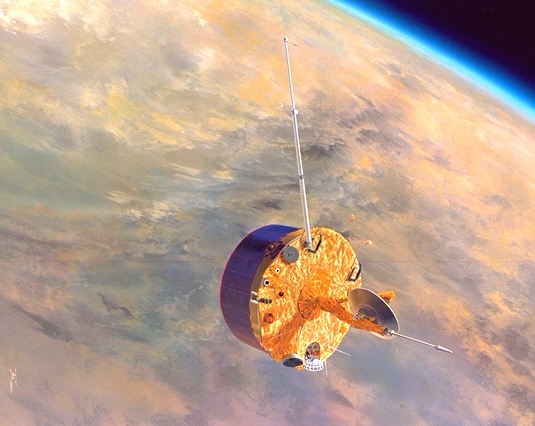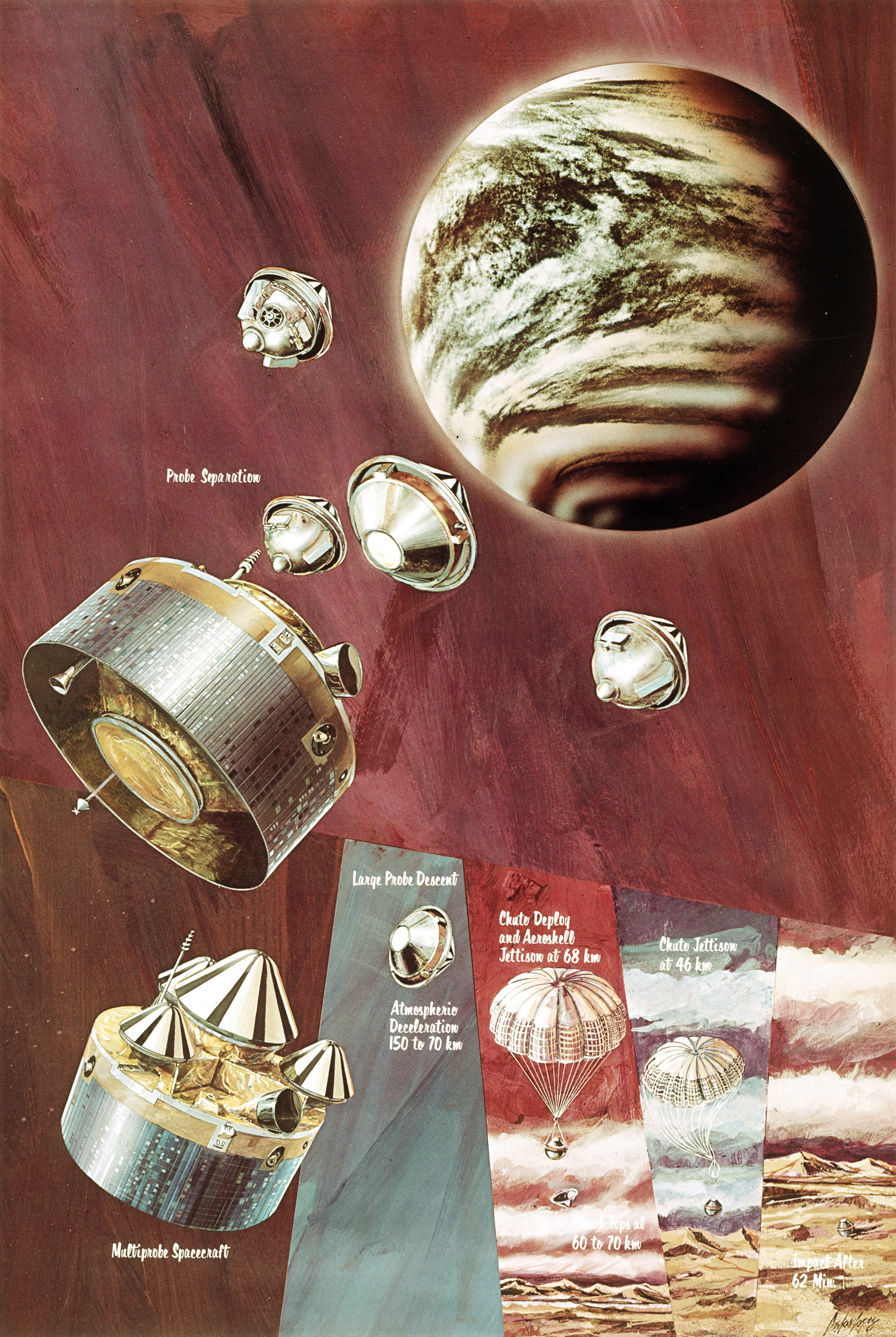Pioneer Venus Project on:
[Wikipedia]
[Google]
[Amazon]
The Pioneer Venus project was part of the

 The orbiter was launched on May 20, 1978 on an
The orbiter was launched on May 20, 1978 on an

 The Pioneer Venus Multiprobe was launched on August 8, 1978 on an Atlas-Centaur rocket. It consisted of a 290 kg
The Pioneer Venus Multiprobe was launched on August 8, 1978 on an Atlas-Centaur rocket. It consisted of a 290 kg Pioneer Venus Probes
NASA Goddard Space Flight Center, 2005. They had no parachutes and the aeroshells did not separate from the probe. Two of the small probes reached the surface, and one of these, the day probe, continued to broadcast for 67 minutes and 37 seconds after reaching the surface.NASA.
Pioneer Venus 2
', NASA Science: Solar System Exploration, February 3, 2021. Retrieved 24 April 2022. The Pioneer Venus
NASA: Pioneer Venus Project Information
Pioneer Venus Program Page
b
NASA's Solar System Exploration
NSSDC Master Catalog: Spacecraft Pioneer Venus Probe Bus
(Other components of the mission have their own pages at this site too.)
specifications at NASA *
The Pioneer Venus Orbiter: 11 years of data.
Results published on May 1, 1990.
Art for the mission
{{DEFAULTSORT:Pioneer Venus Missions to Venus Pioneer program 1978 in spaceflight Spacecraft launched in 1978
Pioneer program
The Pioneer programs were two series of United States lunar and planetary space probes. The first program, which ran from 1958 to 1960, unsuccessfully attempted to send spacecraft to orbit the Moon, successfully sent one spacecraft to fly by the ...
consisting of two spacecraft, the Pioneer Venus Orbiter
The ''Pioneer Venus Orbiter'', also known as ''Pioneer Venus 1'' or ''Pioneer 12'', was a mission to Venus conducted by NASA as part of the Pioneer Venus project. Launched in May 1978 atop an Atlas-Centaur rocket, the spacecraft was inserted into ...
and the Pioneer Venus Multiprobe
The Pioneer Venus Multiprobe, also known as Pioneer Venus 2 or Pioneer 13, was a spacecraft launched in 1978 to explore Venus as part of NASA's Pioneer program. This part of the mission included a Satellite bus, spacecraft bus which was launched ...
, launched to Venus
Venus is the second planet from the Sun. It is often called Earth's "twin" or "sister" planet for having almost the same size and mass, and the closest orbit to Earth's. While both are rocky planets, Venus has an atmosphere much thicker ...
in 1978. The program was managed by NASA
The National Aeronautics and Space Administration (NASA ) is an independent agencies of the United States government, independent agency of the federal government of the United States, US federal government responsible for the United States ...
's Ames Research Center
The Ames Research Center (ARC), also known as NASA Ames, is a major NASA research center at Moffett Federal Airfield in California's Silicon Valley. It was founded in 1939 as the second National Advisory Committee for Aeronautics (NACA) laborat ...
.
The Pioneer Venus Orbiter entered orbit around Venus on December 4, 1978, and performed observations to characterize the atmosphere
An atmosphere () is a layer of gases that envelop an astronomical object, held in place by the gravity of the object. A planet retains an atmosphere when the gravity is great and the temperature of the atmosphere is low. A stellar atmosph ...
and surface of Venus. It continued to transmit data until October 1992.
The Pioneer Venus Multiprobe deployed four small probes into the Venusian atmosphere on December 9, 1978. All four probes transmitted data throughout their descent to the surface. One probe survived the landing and transmitted data from the surface for over an hour.
Overview
The Pioneer mission consisted of two components, launched separately: an orbiter and a multiprobe.Orbiter

 The orbiter was launched on May 20, 1978 on an
The orbiter was launched on May 20, 1978 on an Atlas-Centaur
The Atlas-Centaur was a United States expendable launch vehicle derived from the SM-65 Atlas D missile. The vehicle featured a Centaur (rocket stage), Centaur upper stage, the first such stage to use high-performance liquid hydrogen as fuel. La ...
rocket. The orbiter's mass was . The Pioneer Venus Orbiter was inserted into an elliptical orbit around Venus on December 4, 1978. It carried 17 experiments (with a total mass of 45 kg):
*a cloud photopolarimeter to measure the vertical distribution of the clouds
*a surface radar mapper to determine topography and surface characteristics
*an infrared radiometer to measure IR emissions from the Venus atmosphere
*an airglow ultraviolet spectrometer to measure scattered and emitted UV light
*a neutral mass spectrometer
A spectrometer () is a scientific instrument used to separate and measure Spectrum, spectral components of a physical phenomenon. Spectrometer is a broad term often used to describe instruments that measure a continuous variable of a phenomeno ...
to determine the composition of the upper atmosphere
*a solar wind
The solar wind is a stream of charged particles released from the Sun's outermost atmospheric layer, the Stellar corona, corona. This Plasma (physics), plasma mostly consists of electrons, protons and alpha particles with kinetic energy betwee ...
plasma analyzer to measure properties of the solar wind
*a magnetometer
A magnetometer is a device that measures magnetic field or magnetic dipole moment. Different types of magnetometers measure the direction, strength, or relative change of a magnetic field at a particular location. A compass is one such device, ...
to characterize the magnetic field at Venus
*an electric field detector to study the solar wind and its interactions
*an electron temperature probe to study the thermal properties of the ionosphere
The ionosphere () is the ionized part of the upper atmosphere of Earth, from about to above sea level, a region that includes the thermosphere and parts of the mesosphere and exosphere. The ionosphere is ionized by solar radiation. It plays ...
*an ion mass spectrometer
Mass spectrometry (MS) is an analytical technique that is used to measure the mass-to-charge ratio of ions. The results are presented as a '' mass spectrum'', a plot of intensity as a function of the mass-to-charge ratio. Mass spectrometry is us ...
to characterize the ionospheric ion population
*a charged particle retarding potential analyzer to study ionospheric particles
*two radio science experiments to determine the gravity field of Venus
*a radio occultation experiment to characterize the atmosphere
*an atmospheric drag experiment to study the upper atmosphere
*a radio science atmospheric and solar wind turbulence experiment
*a gamma ray burst detector to record gamma-ray burst
In gamma-ray astronomy, gamma-ray bursts (GRBs) are extremely energetic events occurring in distant Galaxy, galaxies which represent the brightest and most powerful class of explosion in the universe. These extreme Electromagnetic radiation, ele ...
events
In May 1992 the orbiter began the final phase of its mission, in which the periapsis was held between 150 and 250 km until the fuel ran out and atmospheric entry destroyed the spacecraft in August 1992.
Multiprobe

 The Pioneer Venus Multiprobe was launched on August 8, 1978 on an Atlas-Centaur rocket. It consisted of a 290 kg
The Pioneer Venus Multiprobe was launched on August 8, 1978 on an Atlas-Centaur rocket. It consisted of a 290 kg bus
A bus (contracted from omnibus, with variants multibus, motorbus, autobus, etc.) is a motor vehicle that carries significantly more passengers than an average car or van, but fewer than the average rail transport. It is most commonly used ...
which carried one large (315 kg) and three small atmospheric probes. The large probe was released on November 16, 1978 and the three small probes on November 20. All four probes entered the Venus atmosphere on December 9, followed by the bus.
The Pioneer Venus large probe was about 1.5 m in diameter and equipped with 7 science experiments. After deceleration from initial atmospheric entry at about 11.5 km/s, a parachute was deployed at 47 km altitude. The probe stopped broadcasting when it impacted the surface. The science experiments were:
*a neutral mass spectrometer
Mass spectrometry (MS) is an analytical technique that is used to measure the mass-to-charge ratio of ions. The results are presented as a '' mass spectrum'', a plot of intensity as a function of the mass-to-charge ratio. Mass spectrometry is us ...
to measure the atmospheric composition
*a gas chromatograph to measure the atmospheric composition
*a solar flux radiometer to measure solar flux penetration in the atmosphere
*an infrared radiometer to measure distribution of infrared radiation
*a cloud particle size spectrometer to measure particle size and shape
*a nephelometer to search for cloud particles
*temperature, pressure, and acceleration sensors
The three small probes were identical to each other, 0.8 m in diameter and 90 kg each small probe. The small probes were each targeted at different parts of the planet;NASA Goddard Space Flight Center, 2005. They had no parachutes and the aeroshells did not separate from the probe. Two of the small probes reached the surface, and one of these, the day probe, continued to broadcast for 67 minutes and 37 seconds after reaching the surface.NASA.
Pioneer Venus 2
', NASA Science: Solar System Exploration, February 3, 2021. Retrieved 24 April 2022. The Pioneer Venus
bus
A bus (contracted from omnibus, with variants multibus, motorbus, autobus, etc.) is a motor vehicle that carries significantly more passengers than an average car or van, but fewer than the average rail transport. It is most commonly used ...
also carried two experiments, a neutral mass spectrometer
Mass spectrometry (MS) is an analytical technique that is used to measure the mass-to-charge ratio of ions. The results are presented as a '' mass spectrum'', a plot of intensity as a function of the mass-to-charge ratio. Mass spectrometry is us ...
and an ion mass spectrometer to study the composition of the atmosphere. With no heat shield or parachute, the bus made measurements only to about 110 km altitude before burning up.
See also
* 1978 in spaceflight *Vega program
Vega is the brightest star in the northern constellation of Lyra. It has the Bayer designation α Lyrae, which is Latinisation of names, Latinised to Alpha Lyrae and abbreviated Alpha Lyr or α Lyr. This star is List of star systems wi ...
* Venera program
References
External links
NASA: Pioneer Venus Project Information
Pioneer Venus Program Page
b
NASA's Solar System Exploration
NSSDC Master Catalog: Spacecraft Pioneer Venus Probe Bus
(Other components of the mission have their own pages at this site too.)
specifications at NASA *
The Pioneer Venus Orbiter: 11 years of data.
Results published on May 1, 1990.
Art for the mission
{{DEFAULTSORT:Pioneer Venus Missions to Venus Pioneer program 1978 in spaceflight Spacecraft launched in 1978